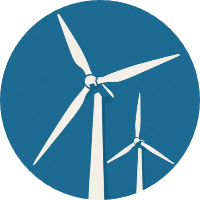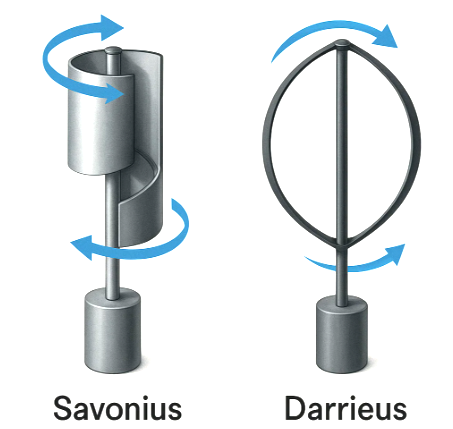
OutWind
Welcome to the Wind Turbine Calculator
Select the type of wind turbine to get started:
Horizontal Axis Turbine (HAWT)

Most common turbine type. Blades rotate perpendicular to wind direction.
ℹ️ Efficient for strong, consistent wind — e.g., offshore or open fields.Vertical Axis Turbine (VAWT)

Rotates around vertical axis. Good for turbulent or urban wind flows.
Calculated Power Output (HAWT):
N/A
Wind Direction Selector (for HAWT)
Wind is currently coming from: 0° (North)
Betz Limit Explanation: The Betz Limit is the maximum theoretical efficiency for a wind turbine. It states that no turbine can capture more than 59.3% of the kinetic energy in the wind.
FAQs
What is the purpose of this calculator?
This calculator helps estimate the power output, financial returns, and environmental impact of horizontal (HAWT) and vertical (VAWT) wind turbines based on user-defined conditions.
What is the Betz Limit?
The Betz Limit (59.3%) is the maximum theoretical efficiency a wind turbine can achieve when extracting energy from wind.
What’s the difference between HAWT and VAWT?
HAWTs rotate around a horizontal axis and are ideal for open areas with steady wind. VAWTs rotate around a vertical axis and perform better in turbulent or urban environments.
What is air density and why does it matter?
Air density affects how much energy is in the wind. Higher air density = more potential power. It depends on temperature, pressure, and humidity.
How do I calculate air density?
Use the formula:
ρ = p / (R × T)
where p = pressure (Pa), R = 287 J/kg·K, T = temperature (K).
What is wind farm wake loss?
Wake loss occurs when turbines interfere with each other’s airflow, reducing the total efficiency of the farm.
What does “Unavailability” mean?
It refers to the percentage of time a turbine is non-operational due to maintenance, failures, or other downtimes.
Why does the power output change when wind direction changes?
HAWTs are directional—misalignment between wind and blade direction reduces efficiency. VAWTs are omnidirectional and less sensitive to wind angle.
How do energy storage methods affect output?
Storage methods have different efficiencies. The selected method directly impacts how much of the generated power is retained.
Can I use this tool for real project planning?
While the calculator provides solid estimates, real-world projects should involve professional engineering analysis and site-specific data.
What financial data is used?
We use 2025 average electricity prices per kWh by country to estimate potential revenue based on power output and time duration.
How much energy can one wind turbine power?
A large commercial turbine (e.g., 2–3 MW) can power around 1,000 homes per year depending on wind conditions.
Can I use this calculator for Mars or other planets?
Yes, with custom inputs! Just modify the air density and wind speed values to match Martian conditions (e.g., low air density ~0.02 kg/m³).
Why do turbine blades have that curved shape?
They're shaped like airplane wings (airfoils) to generate lift, which causes the blades to spin with high efficiency.
Why are wind turbines usually white?
White minimizes visual impact and reflects sunlight, reducing heat buildup in the blades and preventing material fatigue.
Why do turbines have 3 blades, not 4 or 5?
Three blades offer the best balance of efficiency, cost, and structural stability. More blades add weight and reduce speed.
How do I know if a site is good for a wind turbine?
A good site has consistent winds over 5 m/s, low turbulence, and minimal obstacles. Use wind resource maps or real-time data.
Is wind energy really carbon-free?
Turbines have some carbon footprint during manufacturing, but their operational emissions are nearly zero, making them one of the cleanest energy sources.
Can wind turbines work at night?
Yes! Wind turbines operate 24/7 as long as there's wind — they don’t rely on sunlight like solar panels.
Why are wind farms often located on hills or open plains?
Higher elevations and unobstructed areas allow faster and steadier winds, which greatly improve turbine performance.
How loud is a wind turbine?
From 300 meters away, a turbine is about as loud as a refrigerator (35–45 dB). Up close, it can be around 90 dB.
Can wind turbines overheat?
Yes, especially in hot environments with poor airflow. That’s why many turbines include cooling systems in the nacelle.
What’s inside the nacelle of a wind turbine?
It houses the gearbox, generator, brake system, cooling units, and control electronics — essentially the brain and muscles.
What is the carbon payback time for a wind turbine?
On average, it takes 6 months to 1 year for a turbine to offset all the carbon used to manufacture and install it.
Why do turbines sometimes spin without wind?
They may be in maintenance or testing mode. Sometimes motors rotate the blades slowly to prevent mechanical stress.
Do all countries use the same turbine models?
No. Models vary based on climate, regulation, grid standards, and manufacturer availability (e.g., offshore vs inland, icy climates, etc.).
Can small wind turbines power a home?
Yes, small turbines (2–10 kW) can meet the needs of a single home, especially in off-grid or windy rural locations.
Why do wind turbines shut off in low wind?
If wind speed drops below the cut-in speed (usually ~3 m/s), the turbine stops to prevent inefficient operation and wear.
How does blade length affect power?
Longer blades sweep a larger area, capturing more wind and increasing power output — power increases with the square of blade length.